The iPhone 6 Review
by Joshua Ho, Brandon Chester, Chris Heinonen & Ryan Smith on September 30, 2014 8:01 AM EST- Posted in
- Smartphones
- Apple
- Mobile
- iPhone 6
GPU Performance
While we don't quite have real games to benchmark against, we do have benchmarks that are reasonably good approximations of games, which heavily stress the GPU. For the most part, this means that we can see the performance of the A8's PowerVR GX6450 GPU but there are some aspects that are CPU-bound, which we'll discuss after the results.
Edit: Before I get into the results, I must caution that Basemark X will have inaccurate on-screen results as the benchmark was made using XCode 5.x in order to keep scores comparable between versions 1.1 and 1.1.1. This doesn't affect the overall score, which is solely calculated based upon off-screen performance.
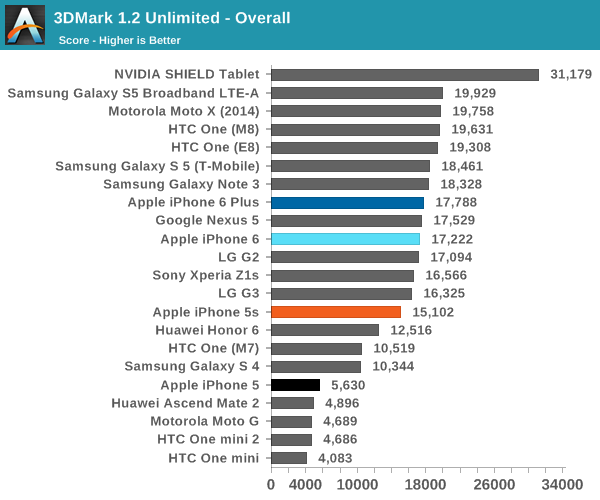
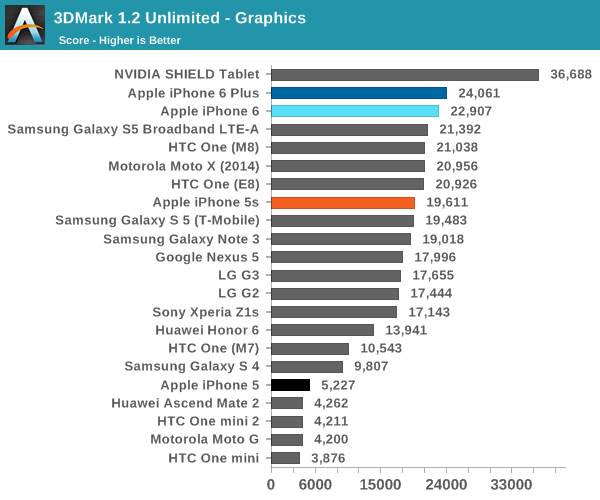
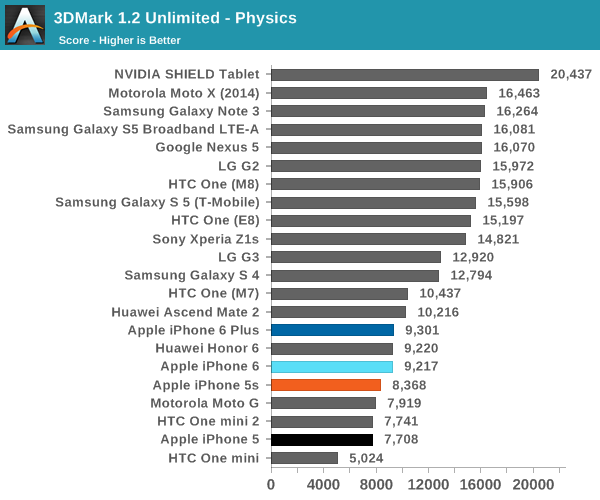
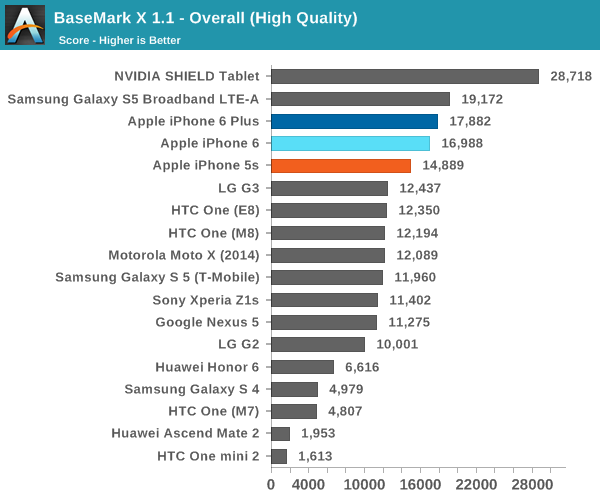

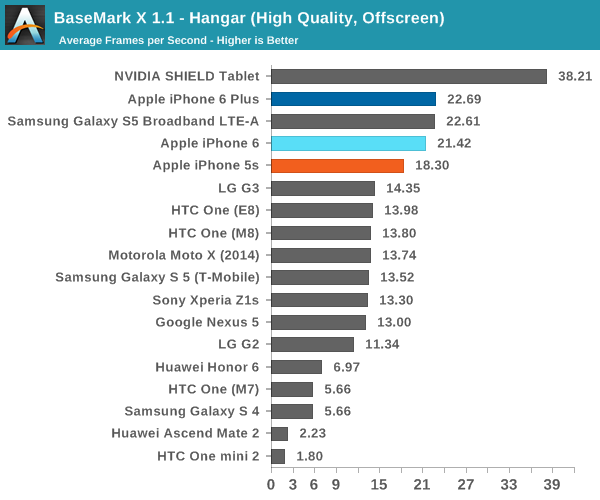

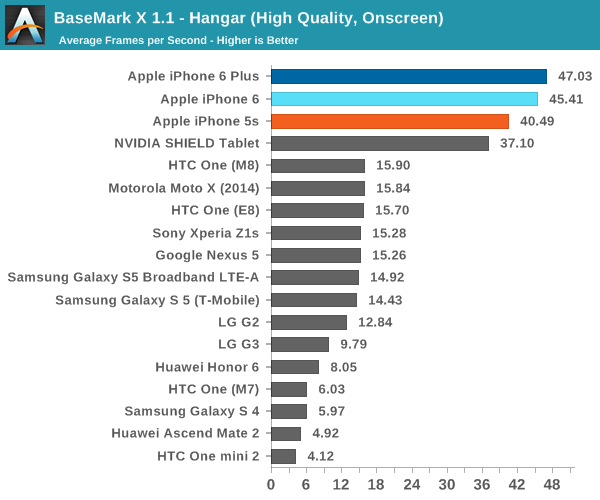
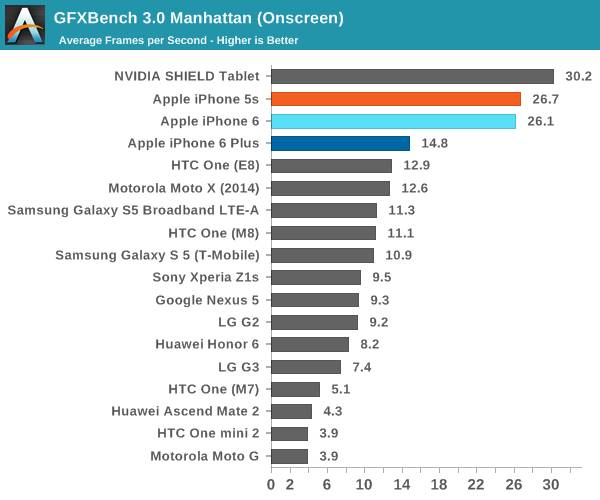


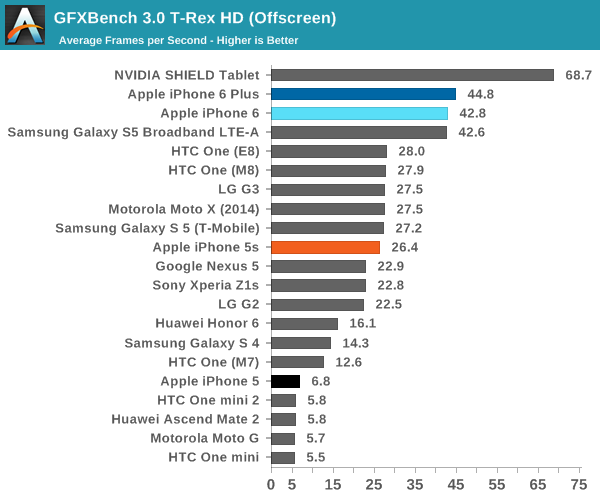
For the most part, we see that the GX6450 is at about the same level as Qualcomm's Adreno 420, which seems to track closely to expectations given that the A7's GPU was around the same performance as the Adreno 330. The 3DMark test does have an interesting result, but it seems that this is because 3DMark's physics test has a strong amount of data dependency that restricts the level of out of order execution that can be done. NVIDIA's Tegra K1 is the current leader in graphics performance, but of course it's also in a tablet instead of a smartphone so it's not a direct competitor.
NAND Performance
As we move towards the goal of seamless performance in everyday tasks, one significant factor is IO performance. While there's definitely a minimum level of performance that allows for generally acceptable smoothness, there's value in having higher storage performance (e.g. prevent bottlenecking in situations such as updating apps in the background). In order to test this, we use Androbench with some custom settings on Android and a custom utility developed by Eric Patno for iOS, who has been quite helpful with furthering our efforts to test storage performance.
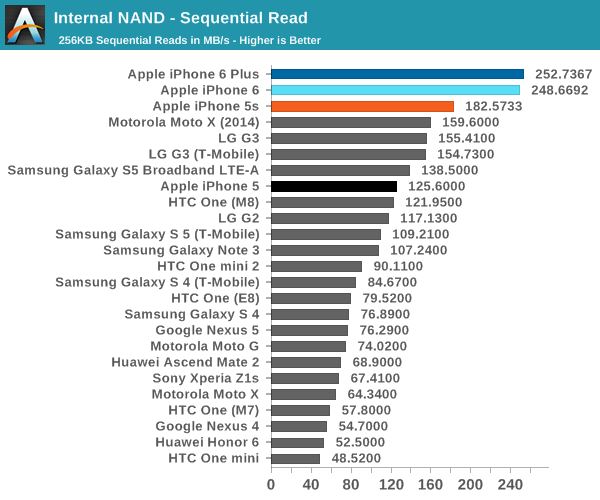
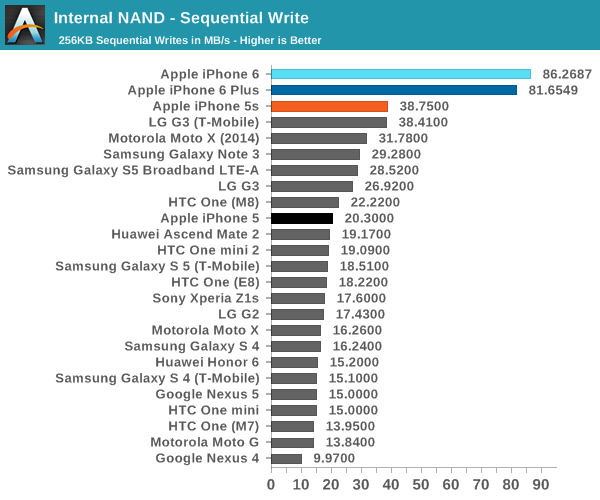
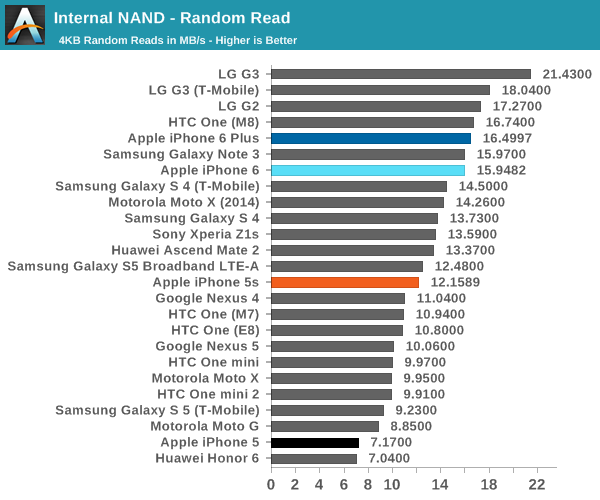
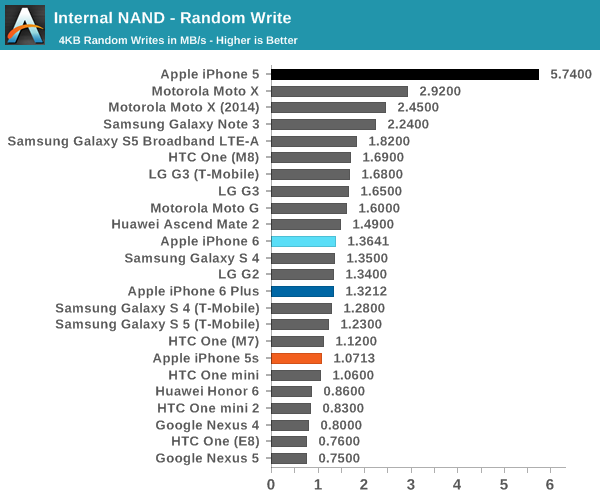
As this is the first time that we've looked into NAND performance on iOS devices, it's definitely worth scrutinizing the data a bit more closely than in most cases. There are a few notable cases here, which are the class-leading speeds for sequential reads and writes on the iPhone 6, but also the rather middling random read and write speeds for the iPhone 6 and 5s. The oddest result is definitely the iPhone 5, which is Ryan's personal unit and while the random read speeds are on the low side, random write speeds are easily record-setting.
In practice, with tablets and smartphones being less multitasking heavy than PCs/laptops, the sequential scores are probably slightly more relevant to the overall user experience. The iPhone 6 results show a significant increase in performance over the iPhone 5s in all of the tests, which is always good to see.










531 Comments
View All Comments
ryanbrancel - Tuesday, September 30, 2014 - link
Yes, you would think call quality would be a high consideration. Maybe it is too subjective, or hard to test. From what I've heard the voice call quality is not that good compared to the competition. For example, it trails behind GS5 in call quality from several comparison reviews I've seen. It appears BlackBerry Passport is the leader in this area now.beggerking@yahoo.com - Tuesday, September 30, 2014 - link
720p screen... no qi charging, half working NFC... no removable battery, no micro sd card support, not waterproof... cost $850... reminds me of year 2012...reviewer must be a time traveler who still lives in 2012 to recommend such a phone at such price tag.
doobydoo - Wednesday, October 1, 2014 - link
Someone doesn't understand technology. I think you're on the wrong site.DorkMan - Thursday, October 2, 2014 - link
BUT the phone can flex better. Where's Anandtech's review of this feature?A design mistake. If the issue were with a new Samsung phone, you can believe Apple would be laughing its head off. But it's not. Jobs would NEVER have cleared the design. That's what's been lost.
throwaway234 - Tuesday, September 30, 2014 - link
Where is the comparison to any of the Intel Atom SOC's? Would be very interesting to compare these.shm224 - Wednesday, October 1, 2014 - link
"For those that are unfamiliar with our test suite the CPU-based tests are mostly browser-based benchmarks. Once again, although I’m not quite happy with the state of benchmarking things we’re getting close to a more platform-agnostic solution."Can anyone please explain why "browser-based benchmarks" are better than CPU benchmarks and why they are listed under "CPU performance"?
There is plenty of evidence that web-browser benchmark figures varies as much as 88% from browser to browser on the same platform. And this makes it much worse than whatever CPU benchmarks out there -- GeekBench or Antutu for instance. Yet Anandtech keeps using this flawed metric, while complaining that they aren't happy. No kidding, right?
blackcrayon - Wednesday, October 1, 2014 - link
They're still useful for comparing devices that are running the same OS and browser, such as an iPhone 6 vs an iPhone 5s. And probably somewhat useful for comparing what the benchmark is testing - javascript may just be faster on an iPhone 6 than on any other phone at the moment- whether that matters to your use case of course is another matter.shm224 - Wednesday, October 1, 2014 - link
Sure, yes I understand that it makes sense to compare one product/browser line, but there is no reason to list it under "CPU performance," with other smartphones as if they are comparing CPU performances. Anandtech can omit the CPU performance altogether if they feel that there is no benchmark good enough to meet their requirement. It's that simple.MykeM - Wednesday, October 1, 2014 - link
Great review. I read it last night and the display measurement alone was intriguing enough that I went to Apple.com and see if I could reserve one from my local Apple Store. Luckily there was one in Space Grey (my colour of choice) and 128GB (a bit more than I wanted to pay). But with Apple trade in program, I ended up paying much less than I was expecting (hint: less than I would if I were to buy a Nexus 5),Coming from the iPhone 5 which itself has a pretty good display (I remember reading Chris' write-up on the iP5 display), I'm more than pleased with the iPhone 6 display. The brightness distribution (on all white background) is simply astounding. I'm still playing with the phone but so far I'm quite impressed.
Ancillas - Wednesday, October 1, 2014 - link
Gotta love the extremists flocking to either love or hate Apple. It may as well be a religious war. Xbox or Playstation, Apple or Android, AMD or Intel. Buy the products that are right for you, and be happy about it. The end.